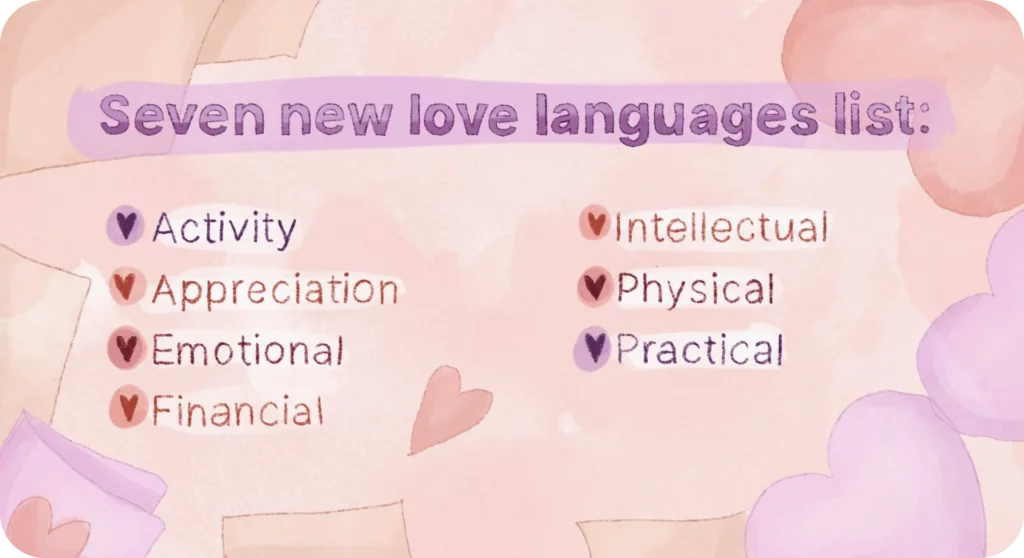When do you feel most loved – in the middle of an intellectual discussion with your partner, or when they gently stroke your head, or when they show financial generosity by buying you something you wanted? These are all love languages, but do we know everything about them? So the question is, what are the 7 love languages?
Dr. Gary Chapman’s love languages study took off in the ’90s and is still a go-to for relationship advice today. But after taking another look at his book “The 5 Love Languages: The Secret to Love That Lasts”, it turns out there might be more than just five love languages. There could actually be seven.
In this article, we will review these new love languages and find out how they can help make your relationship stronger.
Seven Modern Love Languages
The seven new love languages reveal how people show and receive love differently.
Here’s a deeper dive into each of the 7 love languages, with examples and explanations:
1. Activity
People with the Activity love style feel like when their partner takes an active interest in their hobbies or passions. This could be an activity together or supporting them in their interests.
For example, if your partner loves hiking or bouldering but you’re not really into it, someone with this love style would feel loved if you joined them for a hike or training or showed enthusiasm to share experiences.
For these people, love is about sharing time and energy on things they care about. It’s less about grand gestures and more about the small, shared moments spent together. Over time, these shared activities can bring the relationship closer and create lasting memories.
2. Appreciation
People with an Appreciation love style feel loved when their partner gives them compliments, praise, or says thank you. They enjoy hearing what their partner likes and admires about them.
To illustrate, if your partner regularly tells you how beautiful you are or expresses how much they admire your sense of humor, or uses any other words of affirmation for women, someone with this love style would feel deeply loved and appreciated.
3. Emotional
Another one of the 7 love languages is Emotional. Those who focus on it feel most loved when their partner tries to be emotionally available and present. They value their partner’s support during difficult moments and celebrate them during high points.
For example, if you’re feeling down after a tough day at work, a partner with this love style will listen without judgment, offer comfort, and emotionally support you. They want to be there for you during the emotional rollercoaster of life.
In these relationships, traits of empathy, emotional intelligence, and vulnerability are the most important. You can take an Emotional Intelligence test to discover more about yourself and make your partner feel valid with their love language.
4. Financial
People with the Financial love style feel loved when their partner is generous with their resources—whether that’s time, money, or energy—and actively makes the relationship financially enjoyable. This could be buying thoughtful gifts or planning a surprise vacation.
In this love language, it’s not just about spending money—it’s about putting your partner’s happiness first. While it might seem materialistic, it’s actually about showing you care by being generous with money to bring them joy or meet their desires.
5. Intellectual
The next one of the seven love languages is Intellectual. Such people feel loved when their partner values their thoughts and ideas and engages in thoughtful conversations and deep discussions on topics they care about, like philosophy, current events, or shared interests.
6. Physical
This love language is all about feeling loved through touch. It’s not just about sexual intimacy but any kind of physical closeness or platonic love that shows you care, like hugs, kisses, holding hands, or cuddling. For example, if your partner often hugs you, holds your hand, or cuddles with you, someone with this love style will feel really loved. Physical touch is the main way of feeling emotionally close and connected for people with Physical love language.
7. Practical
The last one of the 7 love languages is Practical. People with the Practical love style feel loved when their partner shows care through tangible actions and helps out with everyday tasks like chores, errands, or planning. For these people, love is about embracing teamwork and working together to make life easier and more fun. For example, if your partner helps take on extra responsibilities when you’re feeling tired, they’re showing love in a practical, caring way.

Why Are Love Languages Important?
According to Chapman, the father of love languages theory, people are happier in their relationships when both partners share the same love language [1]. However, recent research shows that most people see all love languages as important ways to give and receive love [2].

The seven love languages can overlap, and people may express or receive love in different ways at different times in their lives or relationships. For example, you might prioritize the Physical love style in the early stages of a relationship but later find that Practical or Appreciation becomes more important as you settle into daily life.
Here are some reasons why love languages are important:
- Communication on a deeper level: Responding to a partner’s love language preferences boosts satisfaction in romantic couples, according to research published on PubMed [3]. The reason is knowing each other’s love language helps you show love in ways that really matter to your partner. When we know how to express love in a way that truly resonates with the other person, we create a more connected, harmonious relationship.
- Better adaptability: As relationships grow, so can your love languages. Knowing this helps you keep meeting each other’s needs as things evolve.
- Increased self-awareness: Understanding your own love language helps you communicate what you need and grow as a person.
- Easier conflict resolution: Many relationship misunderstandings come from unmet needs, American Psychological Association found [4]. Knowing each other’s love language helps you avoid frustration and misunderstandings.
“Although love languages aren’t evidence-based, they can offer a meaningful foundation for understanding both you and your partner’s relational needs. Ideally, you want to prioritize connecting to your partner in their preferred love language. At the same time, it’s important for you to receive support and care in your desired love language. This synchronized effect can make for more fulfilling relationships,” – Nicole Arzt, LMFT.
How to Get Your Love Language Heard: 5 steps
If you want your partner to understand how you feel loved truly, here are some steps you can take to make sure your love language is clear and appreciated:
1. Identify Your Love Language
Spend some time reflecting on what makes you feel most loved. If you can’t answer, you can go the opposite way: what do you dislike most in a relationship? What hurts and offends you the most?
For instance, if criticism hurts you the most, one of the love languages you speak is appreciation. If you are upset when your partner overlooks buying you a gift on your anniversary, your love language might be financial. If you are offended by the fact that after work, you didn’t have a deep conversation over dinner, your language could be intellectual.
Think about how you express love for yourself. You would probably like to receive the same in return. You can also use self-reflection questions to ask yourself.
Moreover, you can take a test to find out your love language with the Breeze app. Here, you can also enjoy the Emotional Type Quiz, Happiness Questionnaire, Personality Quiz, and more informative tests and self-checks for your self-discovery journey.
2. Communicate Openly
Share your love language with your partner calmly and clearly once you’ve figured out your love language. Instead of expecting them to guess, be direct about what makes you feel loved. For example, you might say, “I really feel close to you when you do my hobby with me. Can we do it at least once a month?” Aim to emphasize how and why you appreciate this.
Make sure to express your love language positively to keep the conversation constructive. Avoid blaming your partner for not meeting your needs. Instead of saying, “You never give me compliments,” try something like, “I feel so loved when you give me kind words and tell me you appreciate me.”
3. Be Patient and Understanding
If your partner doesn’t immediately start speaking your love language, be patient. It might take time for them to adjust and understand how to be the best version of yourself and show your love in a way that works for you. Remember, just because they don’t naturally express love in your love language doesn’t mean they don’t care.
Keep noticing positive changes, thank them, and let them know it makes you feel loved. For example, saying something like, “I love when you hold my hand—It really makes me feel special,” may help your partner feel good about showing you love.
4. Show Your Partner’s Love Language in Return
When you start speaking one of the 7 love languages that works for your partner, it encourages them to do the same for you, as romantic relationships are often reciprocal, researchers have found [5]. When both people make an effort to understand and speak each other’s love languages, it can strengthen the bond between them.
Here are some examples of how to show love in each of the seven love languages:
- Activity: Plan a fun date, like a short trip or cooking a meal together.
- Appreciation: Write a heartfelt note for your partner telling them how much they mean to you.
- Emotional: Ask about their day and listen attentively to their feelings without distractions.
- Financial: Buy them an unexpected, thoughtful gift or treat them to a nice dinner.
- Intellectual: Share a book, article, or podcast you think they’d enjoy and discuss it.
- Physical: Give your partner a warm hug, hold hands, or cuddle on the couch.
- Practical: Take care of a household chore they dislike, like doing the dishes or laundry.
5. Practice Flexibility
It’s important to remember that love languages can evolve over time, according to SageJournals study [2]. Your partner might need some time to understand your love language fully, and yours may shift as your relationship grows. Be open to adapting and having conversations about how your love needs change as life circumstances change.
We asked Nicole Arzt, LMFT, how to help your partner understand how you feel loved and start to speak your love language.
Be specific about what makes you feel loved. Let your partner know which gestures, tasks, or types of connections you most appreciate. Make sure that you regularly thank them after engaging in one of those activities – this reinforces the effort. And make sure you are also willing to engage with them in their preferred love language. Healthy relationships always require some reciprocal take-and-give.
Sources
- “The 5 Love Languages: The Secret to Love that Lasts,” Gary Chapman.
- SageJournals. Popular Psychology Through a Scientific Lens: Evaluating Love Languages From a Relationship Science Perspective. January, 2024
- PubMed. I love the way you love me: Responding to partner’s love language preferences boosts satisfaction in romantic heterosexual couples. June 2022.
- ResearchGate. Unfulfilled Romantic Needs: Effects of Relationship Status, Presence of Romantic Partners, and Relationship Satisfaction on Romantic Parasocial Phenomena. August 2021.
- PubMed. Reciprocal Relationships: Something for Everyone.
Disclaimer
This article is for general informative and self-discovery purposes only. It should not replace expert guidance from professionals.
Any action you take in response to the information in this article, whether directly or indirectly, is solely your responsibility and is done at your own risk. Breeze content team and its mental health experts disclaim any liability, loss, or risk, personal, professional, or otherwise, which may result from the use and/or application of any content.
Always consult your doctor or other certified health practitioner with any medical questions or concerns
Breeze articles exclusively cite trusted sources, such as academic research institutions and medical associations, including research and studies from PubMed, ResearchGate, or similar databases. Examine our subject-matter editors and editorial process to see how we verify facts and maintain the accuracy, reliability, and trustworthiness of our material.
Was this article helpful?





